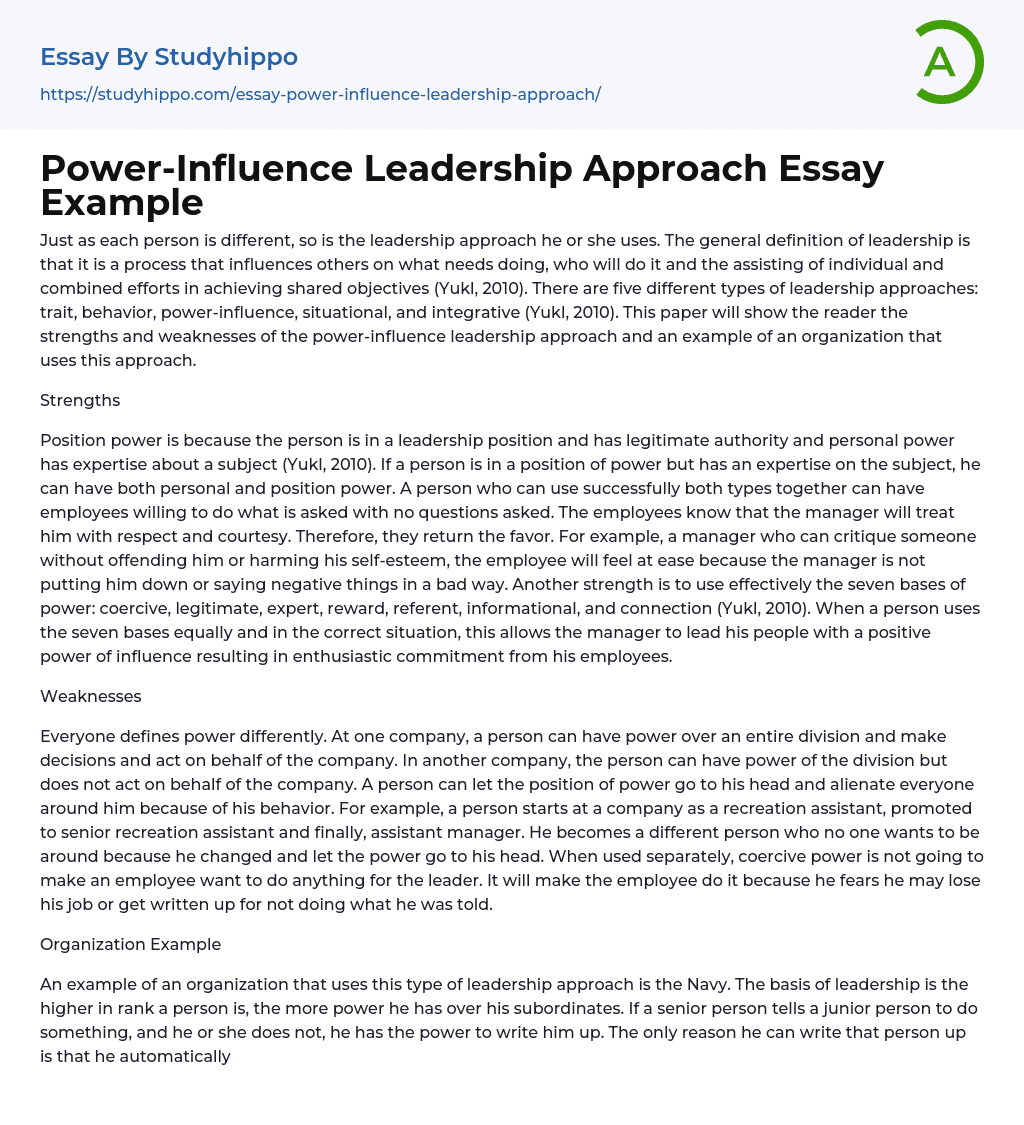Just as each person is different, so is the leadership approach he or she uses. The general definition of leadership is that it is a process that influences others on what needs doing, who will do it and the assisting of individual and combined efforts in achieving shared objectives (Yukl, 2010). There are five different types of leadership approaches: trait, behavior, power-influence, situational, and integrative (Yukl, 2010). This paper will show the reader the strengths and weaknesses of the power-influence leadership approach and an example of an organization that uses this approach.
Strengths
Position power is because the person is in a leadership position and has legitimate authority and personal power has expertise about a subject (Yukl, 2010). If a person is in a posit
...ion of power but has an expertise on the subject, he can have both personal and position power. A person who can use successfully both types together can have employees willing to do what is asked with no questions asked. The employees know that the manager will treat him with respect and courtesy. Therefore, they return the favor. For example, a manager who can critique someone without offending him or harming his self-esteem, the employee will feel at ease because the manager is not putting him down or saying negative things in a bad way. Another strength is to use effectively the seven bases of power: coercive, legitimate, expert, reward, referent, informational, and connection (Yukl, 2010). When a person uses the seven bases equally and in the correct situation, this allows the manager to lead his people with a positive power of influence resulting in enthusiastic commitmen
from his employees.
Weaknesses
Everyone defines power differently. At one company, a person can have power over an entire division and make decisions and act on behalf of the company. In another company, the person can have power of the division but does not act on behalf of the company. A person can let the position of power go to his head and alienate everyone around him because of his behavior. For example, a person starts at a company as a recreation assistant, promoted to senior recreation assistant and finally, assistant manager. He becomes a different person who no one wants to be around because he changed and let the power go to his head. When used separately, coercive power is not going to make an employee want to do anything for the leader. It will make the employee do it because he fears he may lose his job or get written up for not doing what he was told.
Organization Example
An example of an organization that uses this type of leadership approach is the Navy. The basis of leadership is the higher in rank a person is, the more power he has over his subordinates. If a senior person tells a junior person to do something, and he or she does not, he has the power to write him up. The only reason he can write that person up is that he automatically has power over a person who is junior to him. Some people have taken this type of power and used it negatively. When this happens, that person is leading using coercive power.
Conclusion
Employees
know that if they do not do what they are asked, they can be written up. However, if the leader is not using only coercive power, but using all seven bases, the employee will correct himself because he does not want to get in trouble and risk the chance of diminishing his leader’s positive perception of him. If an employee respect’s his leader, the employee will do more than his fair share but, if an employee does not respect his leader, he will do the bare minimum to ensure he will keep his job. If a leader wants to succeed, he needs to have employees who respect him and will do what he asks him to because of his respect for him.
- Being A Leader essays
- Servant Leadership essays
- Leadership Experience essays
- Leadership Qualities essays
- Board Of Directors essays
- Brand Management essays
- Business Ethics essays
- Business Management essays
- Change Management essays
- Comparative Analysis essays
- Decision Making essays
- Dispute Resolution essays
- Knowledge Management essays
- Leadership essays
- Leadership and Management essays
- Manager essays
- Operations Management essays
- Performance Management essays
- Product Management essays
- Project Management essays
- Quality Management essays
- Risk essays
- Risk Management essays
- Scientific Management essays
- Stress Management essays
- supply chain management essays
- Time Management essays
- Total Quality Management essays
- Abnormal Psychology essays
- Abraham Maslow essays
- Attachment Theory essays
- Authority essays
- Behaviorism essays
- Classical Conditioning essays
- Cognitive Psychology essays
- Counseling essays
- Developmental Psychology essays
- Educational Psychology essays
- Erik Erikson essays
- Family Therapy essays
- Jean Piaget essays
- Maslow's Hierarchy Of Needs essays
- Mental Health essays
- Operant Conditioning essays
- Personality Psychology essays
- Positive Psychology essays
- Psychoanalysis essays
- Psychotherapy essays
- Sigmund Freud essays
- Social Psychology essays




